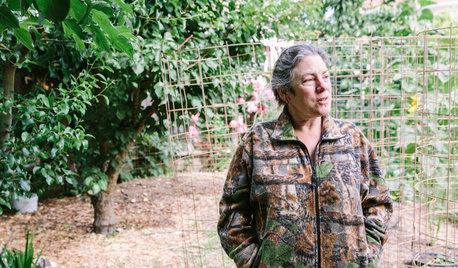What should I look for in a dog food?
hammerslammer
10 years ago
Related Stories

FARM YOUR YARDHello, Honey: Beekeeping Anywhere for Fun, Food and Good Deeds
We need pollinators, and they increasingly need us too. Here, why and how to be a bee friend
Full Story
FRONT YARD IDEASWelcome Edibles Into the Front Yard for Fresh Food and More
Give your front yard design a boost and maybe even make new friends by growing fruits and vegetables
Full Story
FARM YOUR YARD6 Things to Know Before You Start Growing Your Own Food
It takes time and practice, but growing edibles in the suburbs or city is possible with smart prep and patience
Full Story
FARM YOUR YARDTo Get the Food They Believe In, These Urbanites Grow Their Own
Home gardeners farming on their city lots find that local, organic food isn’t the only reward
Full Story
KITCHEN STORAGEPantry Placement: How to Find the Sweet Spot for Food Storage
Maybe it's a walk-in. Maybe it's cabinets flanking the fridge. We help you figure out the best kitchen pantry type and location for you
Full Story
SMALL SPACESCottages: The Comfort Food of Architecture
Soul satisfying and as snug as a favorite sweater, a cottage knows how to roll out the welcome mat
Full Story
KITCHEN DESIGNKitchen Counters: Try an Integrated Cutting Board for Easy Food Prep
Keep knife marks in their place and make dicing and slicing more convenient with an integrated butcher block or cutting board
Full Story
PETSSo You're Thinking About Getting a Dog
Prepare yourself for the realities of training, cost and the impact that lovable pooch might have on your house
Full Story
FUN HOUZZEverything I Need to Know About Decorating I Learned from Downton Abbey
Mind your manors with these 10 decorating tips from the PBS series, returning on January 5
Full Story
HOME TECHTo Feed and Protect: Care for Your Pet From Afar With New Devices
You might miss the nuzzles, but your dog or cat won't miss food, water or monitoring with these high-tech feeders and cameras
Full StoryMore Discussions








christine1950
hammerslammerOriginal Author
Related Professionals
Troutdale Architects & Building Designers · Wauconda Architects & Building Designers · Birmingham Interior Designers & Decorators · Glenbrook Interior Designers & Decorators · Franklin Furniture & Accessories · Milwaukee Furniture & Accessories · San Diego Furniture & Accessories · Langley Park Cabinets & Cabinetry · Glendale Heights Cabinets & Cabinetry · Kentwood Cabinets & Cabinetry · Wilkinsburg Cabinets & Cabinetry · American Canyon Flooring Contractors · Fort Walton Beach Flooring Contractors · Freeport Flooring Contractors · Jacksonville Flooring Contractorssocks
christine1950
hammerslammerOriginal Author
trancegemini_wa
hammerslammerOriginal Author
ryseryse_2004
kitasmommie
hammerslammerOriginal Author
socks
kitasmommie
arkansas girl
hammerslammerOriginal Author
User
arkansas girl
Nancy in Mich
arkansas girl
Nancy in Mich
arkansas girl
User
mudhoney
arkansas girl
Nancy in Mich
arkansas girl
trancegemini_wa
arkansas girl
trancegemini_wa
arkansas girl
mudhoney
Stellabee
User
Nancy in Mich
ryseryse_2004
Nancy in Mich